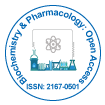
Biochemistry & Pharmacology: Open Access
Open Access
ISSN: 2167-0501
+44-77-2385-9429

ISSN: 2167-0501
+44-77-2385-9429
Opinion Article - (2024)Volume 13, Issue 2
Dicycloplatin is a chemotherapeutic agent created as an alteration of conventional platinum medications such as cisplatin, carboplatin, and oxaliplatin. It consists of a platinum (II) core complexed with 1,1-cyclobutanedicarboxylate and a phenylalanine ligand. The stability of dicycloplatin's molecular structure can be attributed to several factors, including its coordination chemistry, ligand field stabilization, and the specific interactions between the platinum center and its ligands. In the complex, the platinum ion adopts a square planar geometry, a common feature of platinum (II) complexes. This geometry is stabilized by the removal of the 1,1-cyclobutanedicarboxylate ligand, which forms a bidentate chelate ring with the platinum ion. The ring strain inherent in the cyclobutane ring is alleviated by its coordination to the platinum center, contributing to the overall stability of the complex.
The phenylalanine ligand plays an important role in the stability and solubility of dicycloplatin. Phenylalanine, an amino acid, introduces both hydrophilic and hydrophobic elements to the complex. Phenylalanine's aromatic structure facilitates hydrophobic interactions with biological molecules, whereas its amino group can form hydrogen bonds and electrostatic interactions. These characteristics enhance the solubility of dicycloplatin in aqueous and biological environments, facilitating its transport and bioavailability.
Another critical aspect of dicycloplatin's stability is its resistance to hydrolysis. Unlike cisplatin, which rapidly undergoes aquation in aqueous solutions, dicycloplatin indicates a slower hydrolysis rate. This reduced hydrolytic lability can be attributed to the steric protection provided by the bulky 1,1-cyclobutanedicarboxylate ligand. The dicycloplatin's high affinity for binding DNA provides another indication of its stability. Platinum-based drugs exert their anticancer effects primarily by forming covalent bonds with the purine bases of DNA, leading to the formation of intrastrand and interstrand cross-links. These cross-links disrupt the DNA double helix structure, inhibiting replication and transcription processes, ultimately inducing cell death. Dicycloplatin exhibits high reactivity towards guanine residues in DNA, forming stable 1,2-intrastrand cross-links. The stability of these adducts is enhanced by the planar geometry of the platinum center and the conformational flexibility of the 1,1-cyclobutanedicarboxylate ligand, which allows for optimal alignment and binding to the DNA bases.
In addition to its molecular stability, dicycloplatin shows advantageous pharmacokinetic properties, helping to maintain its overall stability in vivo. The drug exhibits prolonged circulation time in the bloodstream, allowing for sustained exposure to cancer cells. This extended half-life can be attributed to its reduced clearance rate and lower susceptibility to renal excretion compared to other platinum-based drugs. The presence of the phenylalanine ligand enhances the plasma protein binding of dicycloplatin, further prolonging its systemic circulation and reducing fast removal. Traditional platinum drugs are often associated with significant nephrotoxicity, neurotoxicity, and gastrointestinal toxicity, restricting their time for therapy. Dicycloplatin's unique molecular structure reduces these adverse effects. The bulky 1,1-cyclobutanedicarboxylate ligand reduces the non-specific binding of dicycloplatin to off-target proteins and tissues, minimizing systemic toxicity. Additionally, the slower hydrolysis rate of dicycloplatin reduces the formation of reactive platinum species that contribute to side effects.
Dicycloplatin's formulation and storage are additionally affected by its structural stability. The complex exhibits good chemical stability in a variety of applications such as temperature and pH ranges. Because of its stability, stable pharmaceutical formulations are easier to create and ensure consistent drug quality and efficacy during treatment and storage. Furthermore, the solubility properties of dicycloplatin allow for the development of various dosage forms, including intravenous solutions and oral formulations, enhancing its versatility and patient compliance. Cancer cells often develop resistance to cisplatin and carboplatin through mechanisms such as increased DNA repair, efflux of the drug, and detoxification by cellular thiols. Dicycloplatin's unique structure and slower hydrolysis rate reduce the chances of these resistance mechanisms, making it effective against platinum-resistant tumors. Additionally, dicycloplatin's ability to form stable DNA adducts enhance its ability to overcome resistance.
Citation: Brouwers A (2024) Dicycloplatin Hydrolysis Resistance: Roles of Ligand Steric Protection and Reactive Platinum Species. Biochem Pharmacol. 13:362.
Received: 13-May-2024, Manuscript No. BCPC-24-33167 ; Editor assigned: 16-May-2024, Pre QC No. BCPC-24-33167 (PQ); Reviewed: 31-May-2024, QC No. BCPC-24-33167 ; Revised: 07-Jun-2024, Manuscript No. BCPC-24-33167 (R); Published: 14-Jun-2024 , DOI: 10.35248/2167-0501.24.13.362
Copyright: © 2024 Brouwers A. This is an open-access article distributed under the terms of the Creative Commons Attribution License, which permits unrestricted use, distribution, and reproduction in any medium, provided the original author and source are credited.